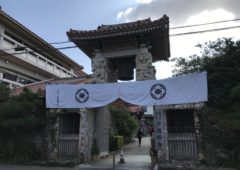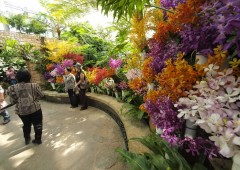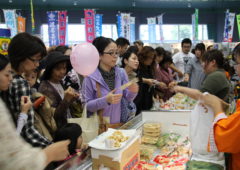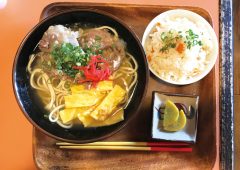2015.05.17
Zazen gives new perspective on meditation
By Tony Nakamoto
In these hectic days, people are really busy. Work, family, friends and even your smart phone keep on calling, and all that make it hard to listen to the voice deep inside our hearts.
Last week, I finally had a chance to try Zazen meditation for the first time, with the hope that it would relieve my worries about my daily hectic routines. “Za” stands for “sit” and “Zen” stands for “meditation.” So, literally, the meaning of Zazen is “sitting meditation.” I invited three friends to join me, all of whom coincidentally had tried Zazen once before, so they were all excited about their second try.
Our Zazen trial was held at Shuri Kannon-do temple in Naha, which is known as a traditional Buddhist temple built in 1618 by King Shonei of the Ryukyu Kingdom. The current priest, Joei Yoshikuni is the 29th generation of the temple. He kindly showed us around inside the temple, and then our Zazen trial started.
Four of us sat cross-legged on small tatami mats in line with small cushions under our hips to support our body. In the main pray hall where we sat, there were great many Buddhist statues and ornaments on display looking on us solemnly. To begin, the priest told us three benefits of Zazen; Choshin, Chosoku, and Choshin, meaning adjusting our body, breath and mind respectively. He said “please don’t worry about your pose now, just stay silent for five minutes without saying any words.”
As soon we started the meditation, we noticed sounds of daily lives; howling dogs and the sound of an airplane, which we might have ignored if we didn’t stay silent. Spontaneously, we started talking to ourselves inside our mind. A scent of burning incense and gentle breeze helped us meditate deeply.
Technically, Zazen was used as a Buddhist way of training. Due to the increase of foreign tourists visiting Japan, it’s getting more attention and some Zen temples in mainland Japan are being flooded with foreigners who are very curious about Buddhist culture. Yoshikuni explained, “We’re hoping this will be a good opportunity for them to understand Japanese culture.”
As a third session of Zazen, He showed us a thin wooden stick, called “Keisaku.” It’s used to slap our back when we want to be “encouraged” during meditation. Two of us had guts to be slapped on our back. The sounds of a slapping echoed inside the hall. We felt itchy but somehow also felt graceful.
An hour long training ended as if it’d been done in an instant. I had relaxed and refreshed feeling just as I felt when I tried Yoga for the first time.
One of attendees, Makio Sahira, a high school teacher said “I am able to have a pure feeling in my heart.” Another participant, Shinobu Ikema, was pleased as, “I could see myself objectively while I sat silently. Our daily life is filled with “Dou” which means movements. On the other hand, Zazen is the idea of “Sei,” meaning stillness. By putting ourselves in stillness, we’ll be able to see ourselves from different point of view.
At the end Yoshikuni closed our trial session with a gentle greeting.
Shuri kannondo conducts Zazen trials based on requests from groups of more than four people. The trial is about one hour long between 1830 and 2100 on any day, if they don’t have memorial services to conduct. It’s conducted only in Japanese. The cost is ¥500 per person. Reservations are required. For more information, call the priest, Mr. Joei Yoshikuni at (098) 884-0565 (in Japanese).




 2024.04.22
2024.04.22 2024.04.10
2024.04.10 2024.01.31
2024.01.31 2024.01.02
2024.01.02 2023.12.27
2023.12.27 2023.11.16
2023.11.16 2023.11.14
2023.11.14 2023.11.10
2023.11.10 2023.10.26
2023.10.26 2023.10.16
2023.10.16






